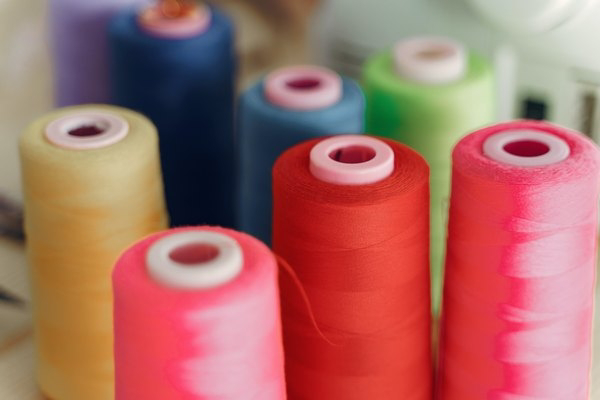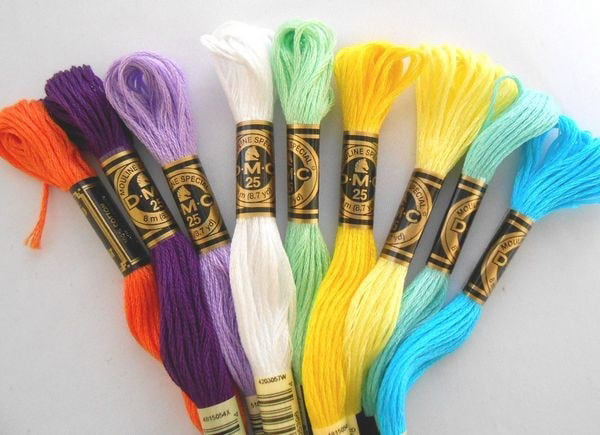Parameter of Sewing thread:-
Parameters of Sewing Thread and Embroidery:-
Introduction:-
The physical appearance and quality of seam is directly related to sewing thread. Specially for making garment the quality depends on the selection of the type of thread have been used. Again embroidery is used for beauty of dress or any type of sign or monogram. So the thread used here should also have some good parameters. There are different parameters for both of these threads, which select for which purpose we choose which type of thread.
Fig: Sewing thread
Objectives:
The different parameters of sewing and embroidery thread are now discussed below:
1. Brand:
There are different threads are available in the market made by different companies. Each company has a specific brand name for their specific product. The threads are also of different brands. Threads of good brands are of good quality and bad brands are of low quality.
So during using we should choose threads looking these brand names.
2. Color:
Color is an important factor for making dress. Because this is to choose matching with dress colour. If we use black colour thread for sewing of white cloth then it would look very odd. Besides the color should also have good fastness properties for different end use
3. Fiber type:-
The quality of sewing thread also depends on the type of fiber used to make the yarn. The thread may be made from natural, synthetic or both of them. In natural fibre there are cotton, linen, silk, viscose etc. In synthetic fiber there are polyester, nylon, aramid, PTFE etc. Usually synthetic threads are stronger than natural thread and mostly used.
Fig: Embroidery thread.
4. Count:
The relation between length and weight of thread expressed in number is called count. There are two systems: direct and indirect. Now the indirect system is used in most of the countries. One of the indirect system is metric count shortly Nm. The no. of length of 1000 m or 1m found per 1000gm or 1gm weight of thread is called metric count. This metric count is called metric number for sewing thread. It is found by multiplying the original count with 3. For cotton thread cotton count is used. The no. of hank or length of 840 yards found per 453.6 gm or 1lb weight of thread is called cotton count. This count is also called cotton ticket number found in the same way. Some times tex is used to express sewing thread count. It is the no. of weight of 1gm found per 1000m or 1km length of thread.
5. TPM &Twist Direction:-
TPM is the no. of turns per 1m length of thread. These turns are given among 2 or more ply of single yarns for making sewing thread. The turns are given in two directions. If the turns are applied in clockwise it is called ‘S’ twist and if in anticlockwise is called ‘Z’ twist.
6. Ply:
Sewing threads are made by twisting between 2 or more plies of single yarn. The more will be the no. of plies the stronger will be the thread. Usually the finishing twist given to these plies of single yarns are opposite to these single yarns twist.
7. Length:
The thread wound to the package has a specific length. It depends on the shape and size of package. It also may depend on the type of thread and use.
8. Tensile Strength:
The amount of load or strength required to break a thread is called tensile strength. It is expressed in gm, kg or lb. It slightly varies with temperature, humidity, applied force and length of thread.
9. Tenacity;
It is found by dividing the tensile strength with the thread count. Tensile strength depends on count that is if the thickness is more the tensile strength will be more and vice versa. But tenacity doesn’t depend on count. Tenacity normally expressed in gm/den or gm/tex.
10. Elongation at Break:
If force is applied on thread then when it is broken at that time the length it extends from the original length is called elongation at break. It is usually expressed in percentage.
11. Loop Strength:
A loop making through another thread loop and taking equal thread length determination of breaking strength of a loop is called loop strength. The loops should be of same thread. Loop strength is strongly related to stitch as well as seam strength.
12. Lubrication:
Different types of finishing are used on thread for easy and decent sewing. Besides it is also applied depending on end use. Lubrication is one of them. It minimizes the friction of needle and cloth with thread and especially in case of synthetic thread the possibility of being damaged by heat of needle. Lubrication should be used at specific quantity and balanced way.
13. Shrinkage;
When swelling the thread if made of cellulose fiber may shrink in length. That is it reduces its length for excessive volume due to swelling. Again when it is dried it recovers its original length. Now this increasing and decreasing of length cause serious problems in seam. After wetting of cloth if the thread shrinks in length there occur crease in cloth and so on. So this shrinkage should be minimized before finishing of thread and before use we should take care of it.
14. Wash fastness;
Wash fastness is actually applied to color resistance against water wash. Suppose a deep color thread is used to sew a light colour fabric. Now if the thread color has low wash fastness then when washing the color will bleed and mix with cloth. So this is a big problem and for that thread should have sufficient color fastness.
15. Rub fastness;
Rub fastness means the resistance of thread against abrasion. The cloth may be rubbed in different ways in daily use. If the thread has not enough rubbing fastness then it will tear or the colour may be stripped or the stitch as well as seam may be harmed. So the thread should have enough rub fastness for its end use.
Sample:
1) Cotton sewing thread
2) Synthetic sewing thread
3) Embroidery thread
Atmosphere:
Temperature 26,°C and humidity 70%.
Parameter found:
The following parameters we found in samples:
1) Brand:
Tiger & Coats.
2) Colour:
Sewing threads are white & embroidery thread is blue.
3) Fibre type:
Cotton & Polyester.
4) Count:
52/3 Tex or cotton ticket no. 52 & 50 Tex.
5) TPM & twist direction:
Cotton thread no of twist 24, direction ‘S’ & another has no twist.
5) Ply:
Cotton threads 3 & no. of filaments 23.
Length:
Cotton thread 5000 m & synthetic thread 1000 m.
6) Tensile strength:
Not found.
7)!Tenacity:
Not found.
8) Elongation at break:
Not found.
9) Loop strength:
Not found.
10) Lubrication:
Not found.
11) Shrinkage:
Not found.
12) Wash fastness:
Not found.
13) Rub fastness:
Not found.
Conclusion:-
The experiment gives us an idea about different types of sewing and embroidery thread and their parameters that will help me to choose a good thread. I would like to give special thanks to our teacher. I am also grateful to our instructors. I think this experiment will be very helpful in my future life.
Ref:-https://textilelearner.net & printerest.




Comments
Post a Comment